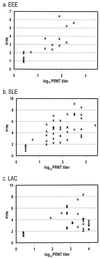Detection of anti-arboviral immunoglobulin G by using a monoclonal antibody-based capture enzyme-linked immunosorbent assay
- PMID: 10790108
- PMCID: PMC86600
- DOI: 10.1128/JCM.38.5.1827-1831.2000
Detection of anti-arboviral immunoglobulin G by using a monoclonal antibody-based capture enzyme-linked immunosorbent assay
Abstract
Monoclonal antibody (MAb)-based capture enzyme-linked immunosorbent assays (ELISAs) for the detection of anti-arboviral immunoglobulin G (IgG ELISAs) were developed for a comprehensive array of medically important arboviruses from the Alphavirus, Flavivirus, and Bunyavirus genera. Tests were optimized and standardized so that maximum homology could be maintained among working parameters for the different viral agents, enabling a wide range of viruses to be easily tested for at one time. MAbs were screened for suitability as capture vehicles for antigens from the three genera. The final test configuration utilized group-reactive MAbs eastern equine encephalitis virus 1A4B-6, dengue 2 virus 4G2, and La Crosse encephalitis virus 10G5.4 to capture the specific inactivated viral antigens. Serum IgG was detected by using alkaline phosphatase-conjugated anti-human IgG (Fc portion). A dilution of 1:400 was chosen as the universal screening serum dilution, with endpoint titrations of serum samples testing positive eliminating occasional false-positive results. IgG ELISA results correlated with those of the standard plaque-reduction neutralization assays. As expected, some test cross-reactivity was encountered within the individual genera, and tests were interpreted within the context of these reactions. The tests were standardized for laboratory diagnosis of arboviral infections, with the intent that they be used in tandem with the corresponding IgM antibody-capture ELISAs.
Figures


Similar articles
-
Standardization of immunoglobulin M capture enzyme-linked immunosorbent assays for routine diagnosis of arboviral infections.J Clin Microbiol. 2000 May;38(5):1823-6. doi: 10.1128/JCM.38.5.1823-1826.2000. J Clin Microbiol. 2000. PMID: 10790107 Free PMC article.
-
Diagnosis of eastern equine encephalomyelitis virus infection in horses by immunoglobulin M and G capture enzyme-linked immunosorbent assay.J Vet Diagn Invest. 1994 Jan;6(1):34-8. doi: 10.1177/104063879400600107. J Vet Diagn Invest. 1994. PMID: 8011779
-
Development of human-murine chimeric immunoglobulin G for use in the serological detection of human flavivirus and alphavirus antibodies.Clin Vaccine Immunol. 2010 Oct;17(10):1617-23. doi: 10.1128/CVI.00097-10. Epub 2010 Aug 25. Clin Vaccine Immunol. 2010. PMID: 20739503 Free PMC article.
-
Five Emerging Neuroinvasive Arboviral Diseases: Cache Valley, Eastern Equine Encephalitis, Jamestown Canyon, Powassan, and Usutu.Semin Neurol. 2019 Aug;39(4):419-427. doi: 10.1055/s-0039-1687839. Epub 2019 Sep 18. Semin Neurol. 2019. PMID: 31533182 Review.
-
Diagnostic Approach for Arboviral Infections in the United States.J Clin Microbiol. 2020 Nov 18;58(12):e01926-19. doi: 10.1128/JCM.01926-19. Print 2020 Nov 18. J Clin Microbiol. 2020. PMID: 32938736 Free PMC article. Review.
Cited by
-
Reverse ELISA for the detection of anti West Nile virus IgG antibodies in humans.Eur J Clin Microbiol Infect Dis. 2007 Jul;26(7):467-73. doi: 10.1007/s10096-007-0309-1. Eur J Clin Microbiol Infect Dis. 2007. PMID: 17554572
-
Evaluation of a West Nile virus immunoglobulin A capture enzyme-linked immunosorbent assay.Clin Diagn Lab Immunol. 2005 Jan;12(1):231-3. doi: 10.1128/CDLI.12.1.231-233.2005. Clin Diagn Lab Immunol. 2005. PMID: 15643014 Free PMC article.
-
Evaluation of widely used diagnostic tests to detect West Nile virus infections in horses previously infected with St. Louis encephalitis virus or dengue virus type 2.Clin Vaccine Immunol. 2011 Apr;18(4):580-7. doi: 10.1128/CVI.00201-10. Epub 2011 Feb 23. Clin Vaccine Immunol. 2011. PMID: 21346058 Free PMC article.
-
Chikungunya virus infections among travelers-United States, 2010-2013.Am J Trop Med Hyg. 2015 Jan;92(1):82-7. doi: 10.4269/ajtmh.14-0442. Epub 2014 Oct 27. Am J Trop Med Hyg. 2015. PMID: 25349374 Free PMC article.
-
Laboratory-Acquired Dengue Virus Infection, United States, 2018.Emerg Infect Dis. 2020 Jul;26(7):1534-1537. doi: 10.3201/eid2607.191598. Emerg Infect Dis. 2020. PMID: 32568040 Free PMC article.
References
-
- Barry M, Patterson J E, Tirrell S, Cullen M R, Shope R E. The effect of chloroquine prophylaxis on yellow fever antibody response: comparison of plaque reduction neutralization test and enzyme-linked immunosorbent assay. Am J Trop Med Hyg. 1991;44:79–82. - PubMed
-
- Centers for Disease Control and Prevention. Addressing emerging infectious disease threats: a prevention strategy for the United States. Morbid Mortal Weekly Rep. 1994;43:RR-5. - PubMed
-
- Clarke D H, Casals J. Techniques for hemagglutination and hemagglutination-inhibition with arthropod-borne viruses. Am J Trop Med Hyg. 1958;7:561–573. - PubMed
Publication types
MeSH terms
Substances
LinkOut - more resources
Full Text Sources
Other Literature Sources
Research Materials

